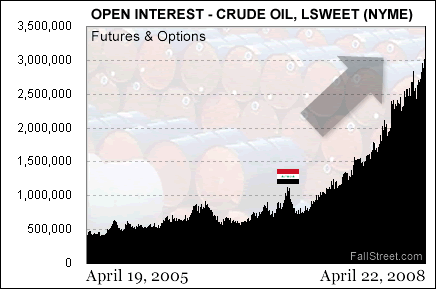|
April 28, 2008
Barrels of Fun as Commodities Continue Run
If they persist long enough, investment manias can temporarily alter an investor’s perception of reality. Such was the case during the 1990s; as more and more investors became intoxicated with internet/tech stocks people started to accept the idea that revenues, profits, and common sense no longer mattered.
The crude oil and commodities mania gripping the world right now is threatening to do much the same thing that the internet bubble of the late 1990s did. To be sure, no longer is an investment in many major commodities based on the fundamentals (or even healthy speculation ahead of a crop report or crude oil inventories reading), but on the simple conclusion that prices have nowhere to go but up. Backing this bullish myopia is a series of popularized investment theories. To wit, ‘peak oil’ is here, China and India will continue to devour more commodities, commodities represent the ultimate hedge against the doomed U.S. dollar, and the always popular ‘barely anyone is invested in commodities, yet!’
The problem with these and other platforms – many of which have some merit - is that they have been spun together to create a Kevlar-like bubble around the negative that is rising prices. As a quick example, crude oil at $120 a barrel doesn’t prompt skepticism that prices are too high, but instead sparks Blodgeteque calls for $200 a barrel. Forget that the 40+% jump in crude this year hasn’t been backed by anything specific, it has been backed by many things that are vague (i.e. the slumping dollar, geopolitical uncertainties, hedge funds, emerging market demand, lack of new investment, etc.)
The Contrarian Take on Crude
Statistically challenged and unable to contradict ‘peak oil’ related speculations with much degree of certainty, the alternative is interpreting participation and price trends. On the former, last week open interest in crude (futures & options) topped 3 million contracts for the first time. If 3 million caps the most recent spike in crude oil, this would be triple the level of [highly speculative] activity seen before the war in Iraq started in 2003.
 |
The question the above chart brings to mind is as follows: is the added interest in crude oil contracts being derived from investment participants that are deeply aware of how volatile the price of crude is historically, or is it the direct result of how poorly so many other investment vehicles are performing? A snippet from a recent Bloomberg article sheds some light on this question:
Oil has also risen because investment funds are buying commodities, Verleger said. “These index funds are playing an important role in lifting prices across the board.”
The returns on the index funds are “negatively correlated” to stocks and bonds, Verleger said.
“That finding causes the leading pension funds to put more money into these commodity funds because it has the effect of diversifying portfolios,” he said. “This is an ongoing processes that probably has another five years to go.”
If the above insights and timeline prove accurate, this would mean that we are in the mid-1990s, Greenspan is just about to utter ‘irrational exuberance’, and that many millions of investors are left to join the party that is commodities. Not to spoil the fun, but something tells me that Bernanke’s Fed is not completely out to lunch, that the negative consequences of $200 a barrel crude would preclude $300 a barrel crude, and that today’s food crisis can not possibly continue to intensify for another 5-years. In other words, while there may indeed be a few more songs left to play, I fail to see the mob of investors lining up to start dancing with the commodities cult 5-years from now. After all, typically speaking those that are hungry and broke do not attend parties.
|
